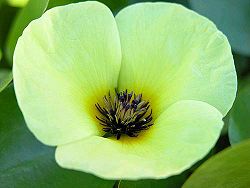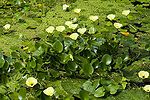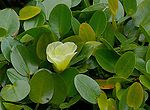Waterpoppy
| Waterpoppy |
|---|

|
| Scientific Classification |
|
| Scientific Name |
|
Hydrocleys nymphoides |
The waterpoppy is a species in the water-poppy family (Limnocharitaceae) known by the scientific name Hydrocleys nymphoides. The waterpoppy is a monocot, meaning that it has only one cotyledon inside its seeds. The flowers of the plant usually have somewhere between three and six petals, and the vascular tissues are grouped together in bundles through out the stem of the poppy. [1] The water poppy is a very interesting and unique plant, showing God's hand in Creation.
Anatomy
The Hydrocleys nymphoides isn't really all that tall, growing 6 to 12 inches. [2] It grows close to the ground and in pools of water up to 15" deep, but prefers 6" of water. The flowers of the water poppy are small and are yellow in color, growing only to be about 2 to 2.5", the center of the flower is a brownish-red color. The flowers of the Hydrocleys nymphoides usually cover the thick, dark green heart shaped leaves, the leaves grow to be only about 2 or 4" in diameter[3] and usually grow in late spring, all throughout summer as well as fall and even, in some cases, into early winter. They need a very moist area to grow, usually a small garden pool will be able to sustain them. [4]
Reproduction
There are four main ways that the Hydrocleys nymphoides are propagated - asexually by cuttings, tubers, bulbs and also sexually. That plant can also be labeled as viviparous [5] meaning that they can germinate while the seed is still attached to the mothering plant.[6] A tuber is a swollen, fleshy bud that will grow on the part of the stem that is buried in the soil, they create shoots where a new plant with someday grow.[7] A bulb has the same basic principles of a tuber, except for the fact that it is short and a lot more modified then the tubers. [8] Sexual reproduction in the water poppy takes place through pollination. Pollination is where the pollen of the plant, or pollen from a different plant, is transferred to the pistil where, eventually a seed will form and grow until it is time for it to be released. [9]
Ecology
Hydrocleys nymphoides are usually be found growing in Venus, Florida as well as Austin, Garland, and Spring Branch Texas.[10] It can also be found in Australia and a few Asian countries, although in Australia they are usually thought of as a weed. [11] The water poppy thrives in bogs or shallow ponds. [12] The water poppy can live in water up to 12 to 15", but would prefer to stay in shallow water only reaching 6" deep. [13] In America, the water poppy is mostly native to Texas and Florida, but really, it can be found practically in every garden pond. [14]
References
- USDA United States Department of Agriculture
- NS State University Erv Evans, Consumer Horticulturist
- Dave's Garden 2000-2009, Dave's Garden
- Answers 2009, Answers Corporation


